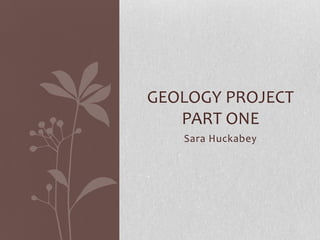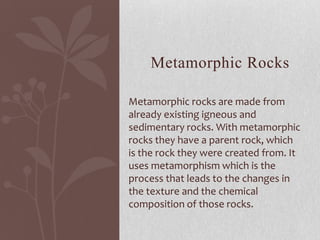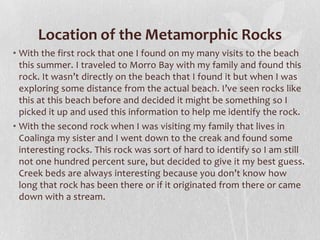Geology project part one
- 1. GEOLOGY PROJECT PART ONE Sara Huckabey
- 2. What is Geology • Geology is the science that pursues an understanding of planet Earth. • With this project we will focus on physical geology. • Physical geology examines the materials composing Earth and seeks to understand the many processes that operate beneath and upon its surface. • We will be examining three different types of rocks and their surroundings of where they were found. • The three types of rock will be Igneous, metamorphic, and sedimentary.
- 3. Igneous Rocks Igneous Rocks form as molten rock cools and solidifies. A very famous formation of Igneous rocks is Mount Rushmore located in the Black Hills of South Dakota. Igneous Rocks from in two ways they either crystallize from magma at depth or the lava solidifies at the Earth’s surface.
- 4. Igneous Rock With rock I believe it could be feldspar, which falls in felsic category. Because of its light color and looking up other pictures of this type of rock it lead me in this direction. It was a pretty big rock and though some parts are smooth it also feels very rough.
- 5. Location of Igneous Rock • This rock I found in another creek bed but by where I live in Bakersfield. I am pretty sure this is not where it originated from, but the rock was interesting compared to all of the other rocks that I found. It didn’t really belong, but this rock had an interesting color to it and it can be found in a lot of different areas. When I went to the creek it was dry so I was able to look around for a bit. In the summer time it is always full of water and everyone is down there cooling off. Creek might not be the right term, but I can’t think of what to call it.
- 6. Metamorphic Rocks Metamorphic rocks are made from already existing igneous and sedimentary rocks. With metamorphic rocks they have a parent rock, which is the rock they were created from. It uses metamorphism which is the process that leads to the changes in the texture and the chemical composition of those rocks.
- 7. Metamorphic Rock This type of rock I want to say is slate. Upon examining the rock it had very fine grain size and had a smooth dull surface. It also resembles shale yet it just seems to be a bit smoother. It’s basically a flat rock which also is a characteristic. It is a black color which means it contains organic material. The second rock I believe could be quartzite. This rock was very hard. It also kind of has pinkish lines if you get to look at it closely. This rock has medium grain size also.
- 8. Location of the Metamorphic Rocks • With the first rock that one I found on my many visits to the beach this summer. I traveled to Morro Bay with my family and found this rock. It wasn’t directly on the beach that I found it but when I was exploring some distance from the actual beach. I’ve seen rocks like this at this beach before and decided it might be something so I picked it up and used this information to help me identify the rock. • With the second rock when I was visiting my family that lives in Coalinga my sister and I went down to the creak and found some interesting rocks. This rock was sort of hard to identify so I am still not one hundred percent sure, but decided to give it my best guess. Creek beds are always interesting because you don’t know how long that rock has been there or if it originated from there or came down with a stream.
- 9. Sedimentary Rocks The word sedimentary comes from the Latin word sedimentum, which mean to settle. Most of Earth’s solid surface consists of sedimentary. Sedimentary rocks are the rocks that contain fossils, which makes them play a big part with geologist.
- 10. Sedimentary Rock With this first rock I believe it can be sandstone. When you examine it closely it has sand size grains over most of the rock. This rock is very abundant after shale, in the sedimentary family of rocks. The second rock is what I believe could be limestone. This rock is not smooth, but rough. It’s white in color and not very big or the one I found is small. The location of this rock was at Pismo beach. It was in these cool caves.
- 11. Location of the Sedimentary Rocks • With the first rock, sandstone, I found this one on my way to Disneyland. We stopped by pyramid lake on the grapevine and I found a few rocks there. It was my first time stopping at pyramid lake so it was very interesting. We didn’t go too far down so I found this rock towards the top when you are looking down at the water. • The second rock I stated that I found it at Pismo beach. I took a lot of trips to the beach this year and found the rock near the beach. We walked down to the beach from our hotel and found all of these cool white caves. They were very interesting and I had never been to this area of the beach before. This was just a little piece that I found near some of the caves.
- 12. References: • Tarbuck, Edward, and Lutgens, Frederick. Earth an Introduction to Physical Geology. Tenth edition











